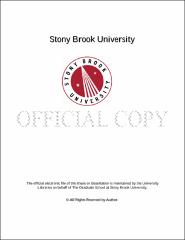| dc.identifier.uri | http://hdl.handle.net/11401/76898 | |
| dc.description.sponsorship | This work is sponsored by the Stony Brook University Graduate School in compliance with the requirements for completion of degree. | en_US |
| dc.format | Monograph | |
| dc.format.medium | Electronic Resource | en_US |
| dc.language.iso | en_US | |
| dc.publisher | The Graduate School, Stony Brook University: Stony Brook, NY. | |
| dc.type | Thesis | |
| dcterms.abstract | Yeast sporulation is the process by which yeast cells under limiting nutrient conditions are able to alter their nuclear division cycle from mitotic division to meiotic division, resulting in development of up to 4 spores per diploid cell. Spores are a hardy cell type that can survive until nutrient conditions improve. Under particularly severe conditions, sporulating cells only produce 2 spores, in an arrangement known as a non-sister dyad (NSD). NSDs contain the two spores with the youngest spindle pole bodies (SPBs), which are produced in meiosis II. The SPBs are the central nucleating point of prospore membranes. A scaffolding component of the SPB, Nud1, has been shown to be phosphorylated at several sites, and be integral to the proper selection of NSD’s during sporulation. I sought to test the hypothesis that Nud1 accumulates phosphorylations over time and this allows the cell to recognize the younger SPB’s by their relative lack of phosphorylation. In an additional experiment we investigated the unknown sporulation function of four related GATA transcription factors induced late in sporulation. | |
| dcterms.abstract | Yeast sporulation is the process by which yeast cells under limiting nutrient conditions are able to alter their nuclear division cycle from mitotic division to meiotic division, resulting in development of up to 4 spores per diploid cell. Spores are a hardy cell type that can survive until nutrient conditions improve. Under particularly severe conditions, sporulating cells only produce 2 spores, in an arrangement known as a non-sister dyad (NSD). NSDs contain the two spores with the youngest spindle pole bodies (SPBs), which are produced in meiosis II. The SPBs are the central nucleating point of prospore membranes. A scaffolding component of the SPB, Nud1, has been shown to be phosphorylated at several sites, and be integral to the proper selection of NSD’s during sporulation. I sought to test the hypothesis that Nud1 accumulates phosphorylations over time and this allows the cell to recognize the younger SPB’s by their relative lack of phosphorylation. In an additional experiment we investigated the unknown sporulation function of four related GATA transcription factors induced late in sporulation. | |
| dcterms.available | 2017-09-20T16:51:23Z | |
| dcterms.contributor | Neiman, Aaron | en_US |
| dcterms.contributor | Luk, Ed. | en_US |
| dcterms.creator | Singer, Patrick | |
| dcterms.dateAccepted | 2017-09-20T16:51:23Z | |
| dcterms.dateSubmitted | 2017-09-20T16:51:23Z | |
| dcterms.description | Department of Biochemistry and Cell Biology | en_US |
| dcterms.extent | 39 pg. | en_US |
| dcterms.format | Application/PDF | en_US |
| dcterms.format | Monograph | |
| dcterms.identifier | http://hdl.handle.net/11401/76898 | |
| dcterms.issued | 2016-12-01 | |
| dcterms.language | en_US | |
| dcterms.provenance | Made available in DSpace on 2017-09-20T16:51:23Z (GMT). No. of bitstreams: 1
Singer_grad.sunysb_0771M_13115.pdf: 1412828 bytes, checksum: 5f7fb5ebb3e5f9b4acad2ab12471a1af (MD5)
Previous issue date: 1 | en |
| dcterms.publisher | The Graduate School, Stony Brook University: Stony Brook, NY. | |
| dcterms.subject | NSD, nud1 | |
| dcterms.subject | Biochemistry -- Cellular biology | |
| dcterms.title | Topics in Yeast Sporulation | |
| dcterms.type | Thesis | |

